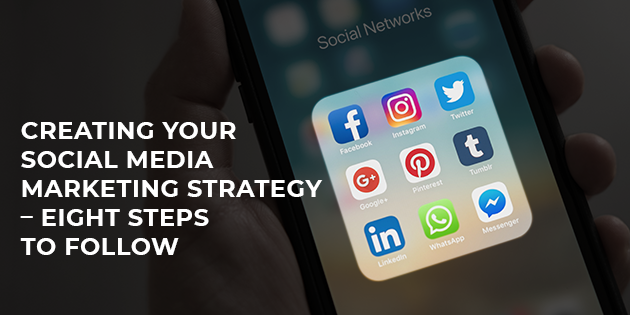Social media is one of the most powerful marketing tools at your disposal. These are the eight steps to follow for creating your social media strategy.
Did you know that 54% of people who use social media rely on it for information when researching a product?
A further 71% will tell people if they have a positive interaction with a brand on social media.
Those stats alone show you that you need to leverage social media in your marketing. It’s the modern-day vehicle for spreading word of mouth. Plus, it gives you a chance to interact with customers directly and ensure they’re seeing the right information when they research you.
We’re going to look at how to create your social media strategy in a moment. First, let’s really dig into why it’s so important in the first place.

Why Do You Need a Social Media Strategy?
Surely using social media is as simple as just creating a few posts per week and sharing them, right?
That’s not the case. You need a strategy in place if you’re going to experience the following benefits:
- A strong ROI that comes from the campaign having a sense of direction. If you’re just posting random content onto social media, you’re sending out mixed messages. A defined strategy lends your posts some focus and makes it more likely that people will pay attention.
- Having a strategy means you’re able to analyse what you do and make tweaks where appropriate. You can check the engagement statistics to see what people click and what they avoid.
- Having a strategy helps your team too. They don’t have to waste time figuring out what to post on social media. Instead, they get to follow a set plan, which makes them more efficient and effective.
- The strategy creates accountability, which means you stay active on social media. This helps you to counteract one of the bigger mistakes that businesses make – having a page that they never update.
Beyond this, having a strategy helps you to build brand engagement. Plus, it helps you to see how you can merge your social media marketing with other campaigns.
You just need to create the strategy now. Here are the eight steps for you to follow.

Step #1 – Set Your Goal
Vague goals, such as improving engagement or getting more likes, aren’t going to cut it. You need a defined purpose for your social media campaign before you start building a strategy.
This is where the SMART framework can help. It’ll help you set goals that actually make sense. Check every goal you consider to see if it’s…
Specific – The more focused the goal, the higher the likelihood of achieving it.
Measurable – You can track the campaign using key metrics.
Achievable – Your goal isn’t so enormous that you’ll feel discouraged and stop chasing it.
Relevant – The goal confronts an important business issue.
Time-Bound – You can achieve the goal within a sensible timeframe.
Step #2 – Research Your Audience and Competition
A scattershot campaign isn’t going to get you anywhere. If you’re trying to appeal to every possible customer with your posts, you run the risk of appealing to none at all.
That’s why researching your audience is so important. Use the data that you have to find out what your existing customers look like and what they want. With that information, you can create targeted social media campaigns that attract a proven audience.
It’s also worth researching your competition. What are they doing to attract their audience? What mistakes have they made that you need to avoid?
Your competitors provide plenty of insight into what you need to do to succeed on social media. Just make sure you don’t copy their strategies. Your audience will notice if you’re posting the same content as a competitor.
Step #3 – Pick the Right Platform
The big mistake that many make is to assume that their brand needs to make an appearance on every social media platform.
That’s not the case. In fact, trying to maintain profiles across every platform leads to you spreading yourself too thin. With a limited marketing budget, you may find yourself struggling.
Choose the platform that’s more relevant for your audience. This will require some research on your part. But on a general level, you’ll find B2B customers tend to favour LinkedIn. Younger consumers love Instagram and Snapchat. However, those platforms only work for you if you’re able to produce attractive images.
Facebook offers plenty of advertising options while Twitter helps you get short and simple messages out there.
With the platform chosen, focus on content type. For example, you won’t be able to post detailed blogs on Twitter. That means your content has to deliver a more focused message.
Step #4 – Create Your Content Calendar
With your goal set, audience targeted, and platform chosen, it’s time to focus on your content.
Don’t assume that you can just post anything. Create a calendar for posting that determines the frequency and the topics you cover.
For the topics, look at what people on your social media profiles talk about. Are there common questions that your followers keep asking? Use them to create articles that appeal directly to the pain points that they’re showing you.
The key is to focus on education first and sales second. Trying to turn every piece you create into a sales pitch will deter many people from reading.
Step #5 – Configure Your Website
The data you collect via your website can inform your social media marketing campaign.
Take Facebook’s Pixel as an example. This is a small snippet of code that you insert into your website. It will track what your visitors do, which allows you to build social media marketing campaigns based on the data.
For example, a Pixel will collect data on people who abandon their shopping carts. You can use this to retarget them with offers and reminders related to the product they expressed an interest in.
Automation Agency can help you to integrate a conversion pixel into your website. Send a ticket to the Concierge service to get started.
Step #6 – Build Your Landing Pages
The ultimate goal of any content that you share on social media is to move the viewer through your sales funnel.
You’re not going to do that using social media alone. In fact, many of your campaigns will involve pointing people towards landing pages, where you make offers or sales.
It’s important to craft individual landing pages for each social media campaign. Relevance is the key here. The page the customer lands on needs to relate to the post that caused them to click. If it doesn’t, you lose the trust and the customer might drop out of your sales funnel.
In addition to relevance, you must also offer social proof. Use testimonials and case studies on your landing pages to show that you deliver on your promises.
Landing page creation is another area where Automation Agency can help you. Send a ticket to the Concierge service to find out how our design team can help.
Step #7 – Import the Data You Gather into Your CRM
Social media can reveal a lot about your customers that you can’t collect using forms.
The more data that you have, the more targeted and effective your marketing efforts become. That’s why it’s so important to integrate your social media activities into your CRM wherever possible. Add the data to what you collect via your website and landing pages.
A ticket sent to the Concierge service is all you need to start integrating your social profiles into your CRM.
Step #8 – Stay on Top of Things
A social media strategy isn’t something you can just create and forget about. It needs constant analysis from a team that’s dedicated to improving your techniques.
Create a team to stay on top of everything that you do on social media. They’ll take responsibility for posting based on your content calendar and using the data that you collect.
Create Your Social Media Strategy
Follow these steps to evolve your social media strategy into a real marketing force. Having a defined goal, creating a calendar, and forming a social media team all keep you accountable.
However, you also need to integrate your social media marketing into your CRM. Plus, you’ll find that the data you collect can help you to build more effective campaigns elsewhere. Those are areas where Automation Agency can help, so send a ticket to the Concierge service.
Of course, you may not be a member yet. If that’s the case, talk to our Right Fit Chatbot to find out if we’re a good fit for you.


